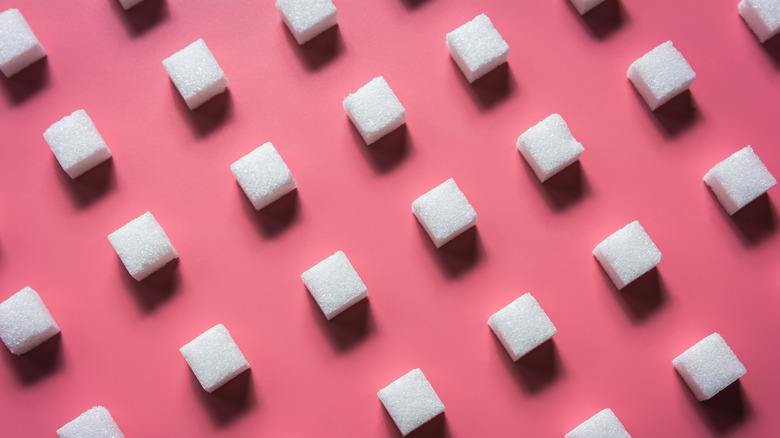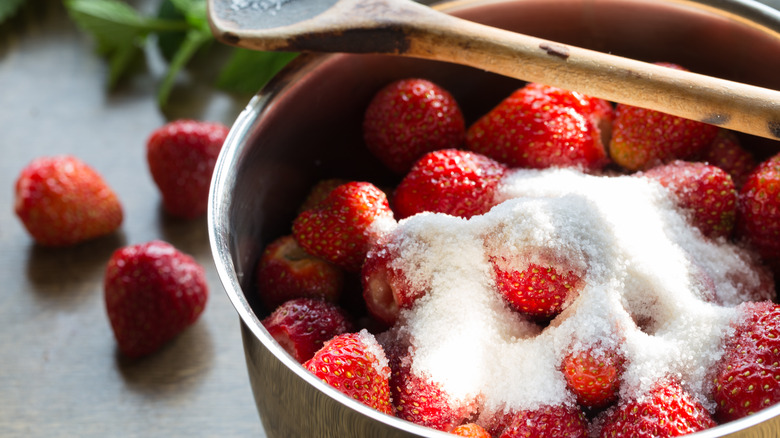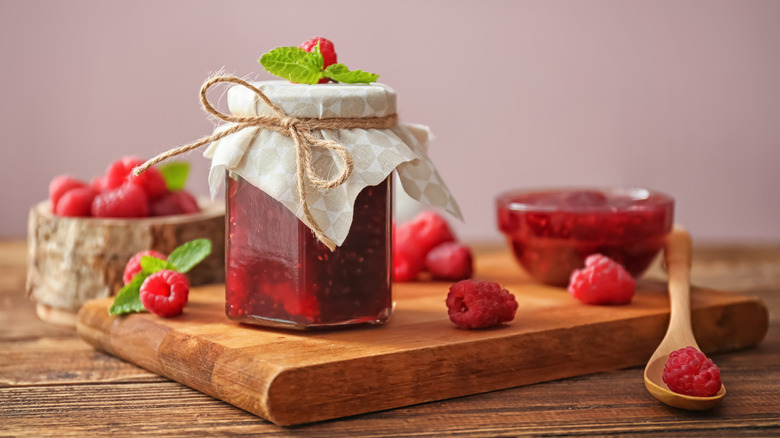The Scientific Reason Sugar Is In Almost Everything
Sugar has a lengthy history full of drama and controversy in America. In more recent decades, health experts all agree that added sugars pose serious health risks. So why are we seeing sugar added to almost every food product on the market? If you compare how much sugar is in healthy drinks like smoothies or plant-based milks, you'd be shocked. Even condiments like salad dressing and pasta sauce are usually loaded. Hey, we all know sugar makes food taste good, but are food companies just piling on the sugar to keep us craving more? Actually, there's science behind sugar that exceeds mere flavor enhancement.
Sugar has preserving qualities that have a huge impact on food safety. You probably don't think of sugar as a preservative, but it actually has similar bacteria-fighting qualities as salt in the right context. Oftentimes, sugar plays a dual role in terms of flavor booster and spoilage stopper, so don't be too hasty to criticize the presence of sugar in packaged food.
Sugar as a natural preservative
Curing refers to the food preservation method wherein an additive draws out the moisture inside the food via osmosis. Salt doesn't have a monopoly on cured foods, though; sugar is in the mix, too. You've probably seen recipes like sugar-glazed ham in which sugar acts as the preserving agent as well as a flavoring factor. It works by absorbing and binding to free water molecules within the food. Less free water available makes for a harsher, drier environment for water-loving bacteria to grow, and that's key to avoiding food spoilage.
In addition to its water-binding capacity, sugar can serve as a vehicle for the production of preservative byproducts within a food. For example, certain yeasts can convert sugar into alcohol (like beer and wine), whereas specific strains of bacteria can ferment sugars into acids that impart tanginess while safeguarding them from spoilage. Here we're talking about fermented foods like kimchi, tempeh, and yogurt. In these cases, the alcohol or acid produced from the sugar acts as the essential barrier between you and a moldy mouthful.
Foods you can make where sugar acts as a preservative
The most common recipes that call on sugar's preservation power are jams, jellies, and marmalades. Sure, sugar imparts fantastic flavor in these recipes, but it's also preventing potential food-borne illness, so don't skimp on it. Take our favorite mixed berry jam recipe, for example. It uses nearly twice as much sugar as fruit by volume, but you'd be remiss if you decreased the amount significantly. After all, fruit contains a lot of natural water, and therefore needs plenty of sugar molecules to sequester them from bacteria's insatiable grasp.
For more creative applications of sugar's bacteria-fighting finesse, set aside the honey-cured ham and try out this maple-cured salmon instead. For an insanely indulgent breakfast, swap in a little candied bacon. You can even decorate your next cake with candied flowers for beautiful edible art.
And if you're wondering about the healthfulness of these products, don't panic. Nutritionists and dietitians generally agree that it's okay to eat sugar in small quantities while eating mindfully. However, to avoid health concerns with excessive amounts, reach for unsweetened products as often as possible — just not when sugar is playing the vital role of preserving the food.


